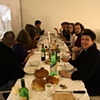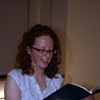
EVENT NO.1
Tent Gallery, Edinburgh, Scotland 2009
St Andrew’s Night Ceilidh
30th November 2009
Materials: traditional Scottish food and beverages, stereotypical Scottish film image projection, candlelight, traditional Scottish music, tables, tablecloth crockery and cutlery - supplied by artist; good cheer, additional beverages and literary readings - supplied by guests.
A St Andrew’s Feast in Tent Gallery for invited guests, where I cooked and baked a feast of traditional Scottish food. Whisky was also supplied. Guests were instructed to each bring a poem to read at the feast for mutual edification.
>>>>
Cèilidh
English pronunciation : KAY-lee
Today, a cèilidh will be familiar to many as a traditional Gaelic social dance event of Scottish or Irish origin, where an array of vigorous set dances are accompanied by spirited and lively fiddle music.
Prior to the advent of discos and nightclubs, cèilidhs were to be found every weekend in most town and village halls throughout Scotland and Ireland. A popular social outlet for many rural communities, cèilidhs also offered opportunities for courtship and marriage proposals.
Historically cèilidhs were simply a social gathering, of any kind, and did not necessarily involve dancing. They were a place of intellectual entertainment and mutual enlightenment, where songs were sung and stories were told; where poetry was recited and ballads rehearsed; where difficult questions were posed and the mind was challenged; where proverbs were quoted, and where a vast array of current affairs and literary matters were discussed and debated.
Highland ceilidhs were invaluable educational resources; the schoolrooms of the past. Families and neighbours would often gather around a peat fire and share personal information. The legacy of the ceilidhs is still significant to Scottish life today, with the lessons learned in these gatherings having set the moral standards.
St Andrew’s Night Ceilidh
30th November 2009
Materials: traditional Scottish food and beverages, stereotypical Scottish film image projection, candlelight, traditional Scottish music, tables, tablecloth crockery and cutlery - supplied by artist; good cheer, additional beverages and literary readings - supplied by guests.
A St Andrew’s Feast in Tent Gallery for invited guests, where I cooked and baked a feast of traditional Scottish food. Whisky was also supplied. Guests were instructed to each bring a poem to read at the feast for mutual edification.
>>>>
Cèilidh
English pronunciation : KAY-lee
Today, a cèilidh will be familiar to many as a traditional Gaelic social dance event of Scottish or Irish origin, where an array of vigorous set dances are accompanied by spirited and lively fiddle music.
Prior to the advent of discos and nightclubs, cèilidhs were to be found every weekend in most town and village halls throughout Scotland and Ireland. A popular social outlet for many rural communities, cèilidhs also offered opportunities for courtship and marriage proposals.
Historically cèilidhs were simply a social gathering, of any kind, and did not necessarily involve dancing. They were a place of intellectual entertainment and mutual enlightenment, where songs were sung and stories were told; where poetry was recited and ballads rehearsed; where difficult questions were posed and the mind was challenged; where proverbs were quoted, and where a vast array of current affairs and literary matters were discussed and debated.
Highland ceilidhs were invaluable educational resources; the schoolrooms of the past. Families and neighbours would often gather around a peat fire and share personal information. The legacy of the ceilidhs is still significant to Scottish life today, with the lessons learned in these gatherings having set the moral standards.






